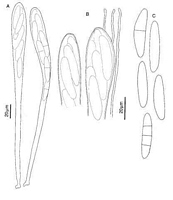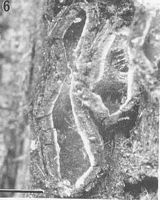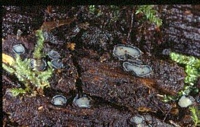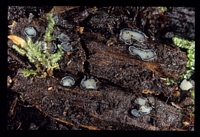|
 Colpoma nothofagi Colpoma nothofagi
BiostatusPresent in region - Indigenous. Endemic
Images (click to enlarge)
Caption: Fig. 2 Colpoma nothofagi (PDD 57523): A, asci. B, apex of asci and paraphyses. C, released
ascospores. | 
Caption: Fig. 4 Colpoma nothofagi (PDD 57523): margin of ascoma in vertical section. Scale = 100
µm. | 
Caption: Fig. 6 Colpoma nothofagi (PDD 57523): macroscopic appearance of ascomata. Scale = 1
mm. | 
Owner: P.R. Johnston | 
Caption: D498, 1990. L. mononrai
Owner: Peter Johnston |
Article: Johnston, P.R. (1991). Rhytismataceae in New Zealand. 5. Wood- and bark-inhabiting species in the genera Colpoma and Propolomyces. New Zealand Journal of Botany 29: 405-410 (http://www.rsnz.org/publish/abstracts.php).
Description: Ascomata 1.5-5 x 1-2.5 mm, elliptic to irregular in outline, erumpent, deeply immersed within
the wood, most of ascomatal wall remaining covered with host tissue, some of the brown to
dark brown wall becoming exposed near the ascomatal opening, the wall along the edge of the
opening creamy white in colour, hymenium translucent yellow. Not associated with anamorph
conidiomata.
Ascomata in vertical section with an upper wall 80-100 µm thick near the base,
increasing to 300-500 µm thick near the ascomatal opening, comprising mostly brown to pale
brown, slightly thick-walled, angular, 5-10 µm diam. cells, but the cells along the outer edge
of the wall darker and thicker walled. The part of the wall adjacent to the ascomatal opening
lined with a 30-65 µm wide, palisade-like layer of 35 µm diam., cylindric, thin-walled, hyaline
cells. Lower wall 30-65 µm thick, comprising dark brown, thick-walled, 4-8 µm diam.,
angular cells, the outer rows of cells darker and thicker walled than the inner rows. A 10-20
µm wide layer of thin-walled, hyaline, cylindric cells separates the hymenium from the lower
wall.
Paraphyses with anastomoses near bases, 1-2 µm diam., undifferentiated or irregularly
circinate at the apex, extending up to 10 µm beyond the asci. Asci 210-330 x (18-)20-26 µm,
clavate-stipitate, tapering to truncate apex, wall unthickened at apex, but often with small
apical pore, nonamyloid, 8-spored, spores confined to upper 90-150 µm of ascus, ascus
development sequential. Ascospores (26-)31-46 x 6-10 µm, oblong-elliptic, 0-3 septate,
hyaline, surrounded by a 1-2 µm thick gelatinous sheath.
Habitat: HABITAT: fallen wood and bark of Nothofagus spp.
Distribution: New Zealand: Gisborne, Fiordland.
Notes: ETYMOLOGY: refers to host substrate.
NOTES: C. nothofagi, with phragmosporous ascospores, keys out to the genus Xyloschizon
in Darker's (1967) key to the Rhytismataceae. However, Darker (p. 1415) noted that
Xyloschizon appears to be segregated from Colpoma simply on the basis of ascospore
septation, and as such is of doubtful validity. I do not consider ascospore septation a useful
character at the generic level in the Rhytismataceae.
|